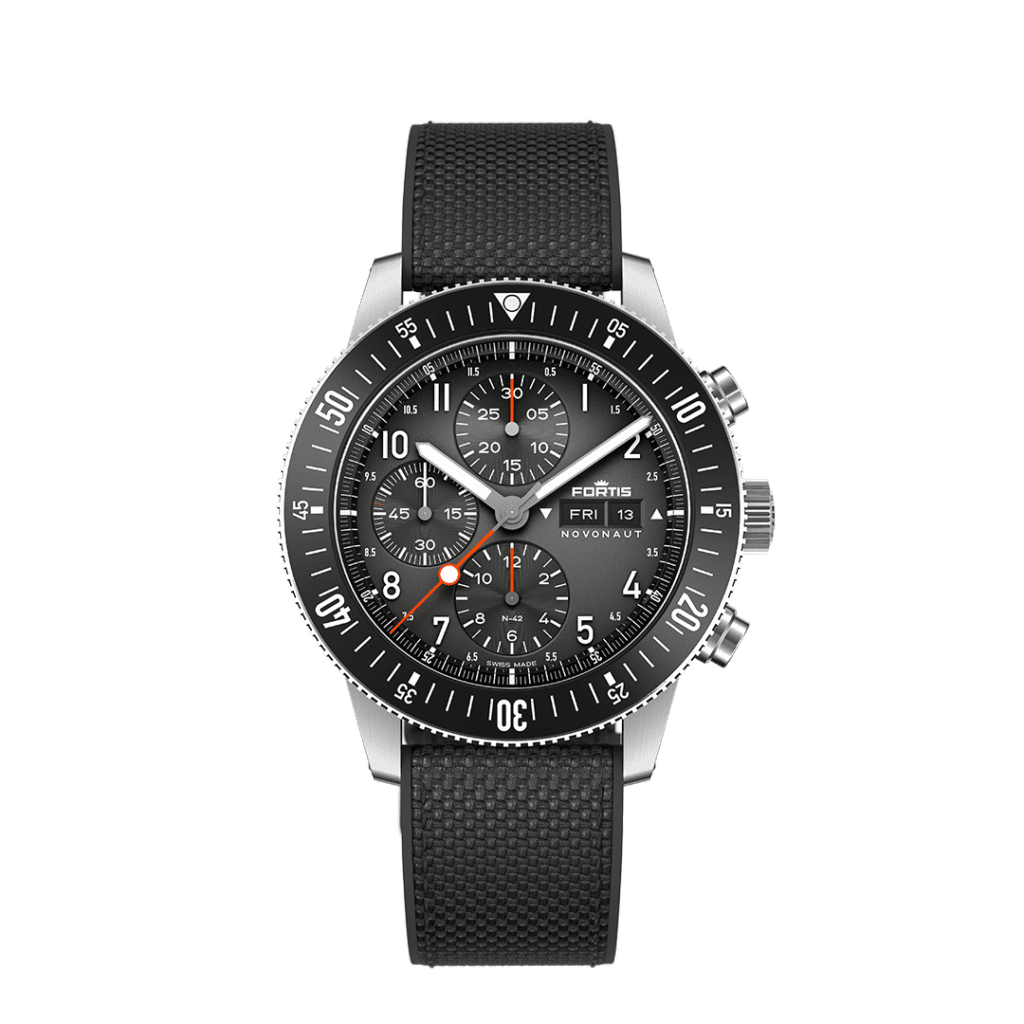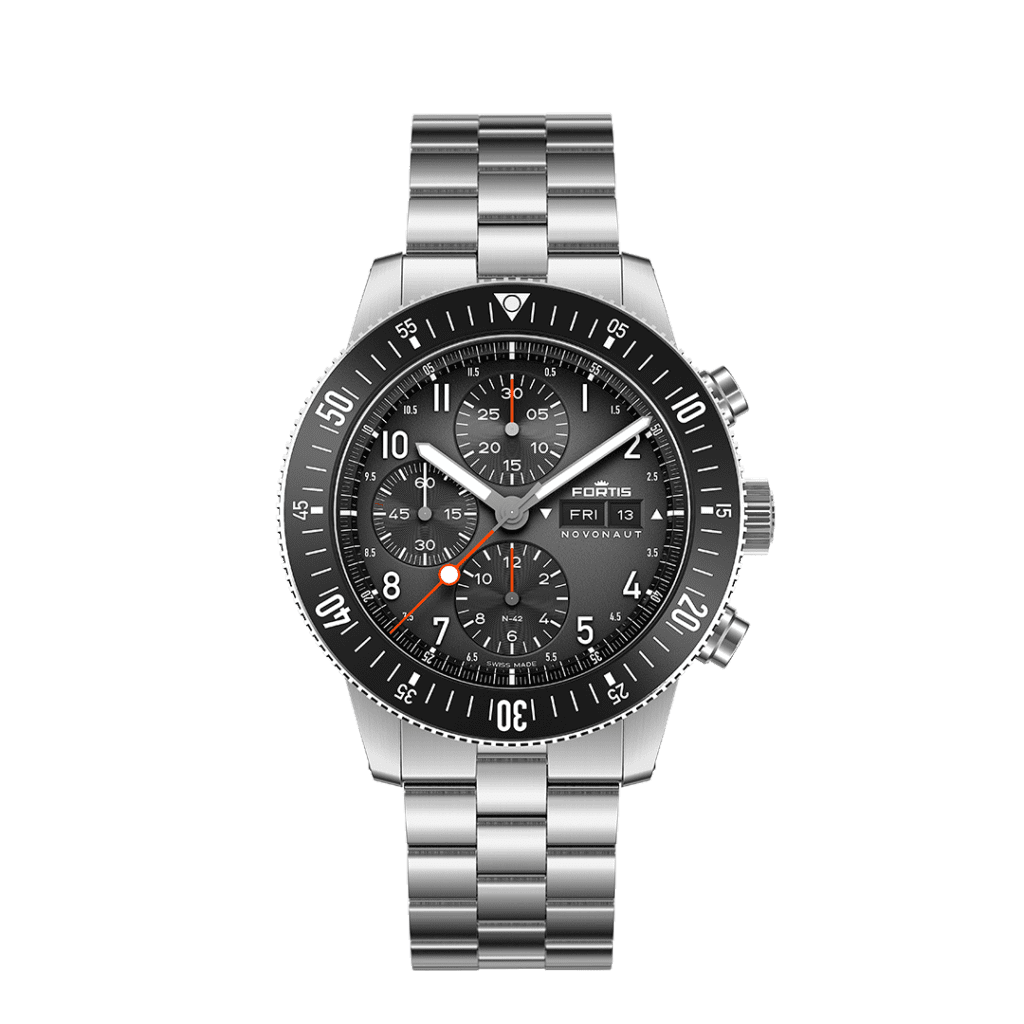Ben: We’re launching a new series on the Tools Of Time Blog, and we welcome your thoughts and ideas as it progresses. We’re calling this series Wrist Shot. The series will primarily focus on watches, offering personal insights on these tools of timepieces and exploring their connections with other interests like photography, cycling, outdoor activities, hi-fi, cars, and more.
Joining me today is Joseph Ramos, the COO and Director of Purchasing & Sales at CW Watch Shop. In our first episode of Wrist Shot, we’ll delve into a new watch that’s been making waves in the watch industry and is now part of Joseph’s personal collection. It might even become part of mine soon. The watch we are discussing today is the Fortis N-42 Novonaut, the successor to a rich lineage of purpose-built tool watches for space exploration.
The History

Ben: Joe, could you give us some background on Fortis? Not many people are familiar with the Fortis brand, or if they are, they may not fully understand their history in creating purpose-built Tool Watches. Let’s discuss their background in producing watches specifically for the Aerospace industry and how the Novonaut is a product of this heritage.
Joseph: Fortis began producing watches for the Russian space agency in the early 90s. Initially, they adopted some references that they were already using, resembling the style of a Tudor Prince Date chronograph or a Daytona-style case. That’s the type of chronograph you’ll see with the early watches used by the Russian space agency.
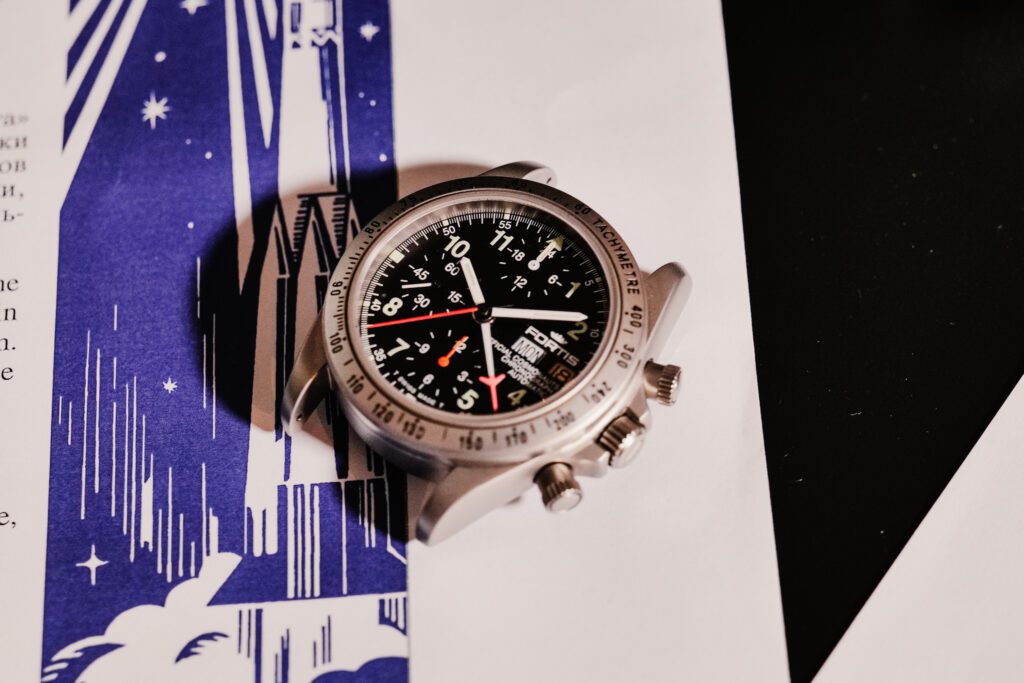
Over time, they realized they needed a more robust design. Unlike previous instances where a space agency would simply adopt an existing watch, such as the Omega Speedmaster with NASA, the Russian space agency worked directly with Fortis to design a watch specifically for their astronauts. The outcome was the B-42 case design, featuring a robust build, large pushers, a big crown, and a bi-directional bezel. It was easy to read at a glance and to navigate.
This watch became integral to the Russian space agency, as it was designed with them in mind. There are even videos of them using it in space, including one where a cosmonaut lets it float inside the International Space Station. On another occasion, during a space walk, a Cosmonaut used it as a makeshift hammer.

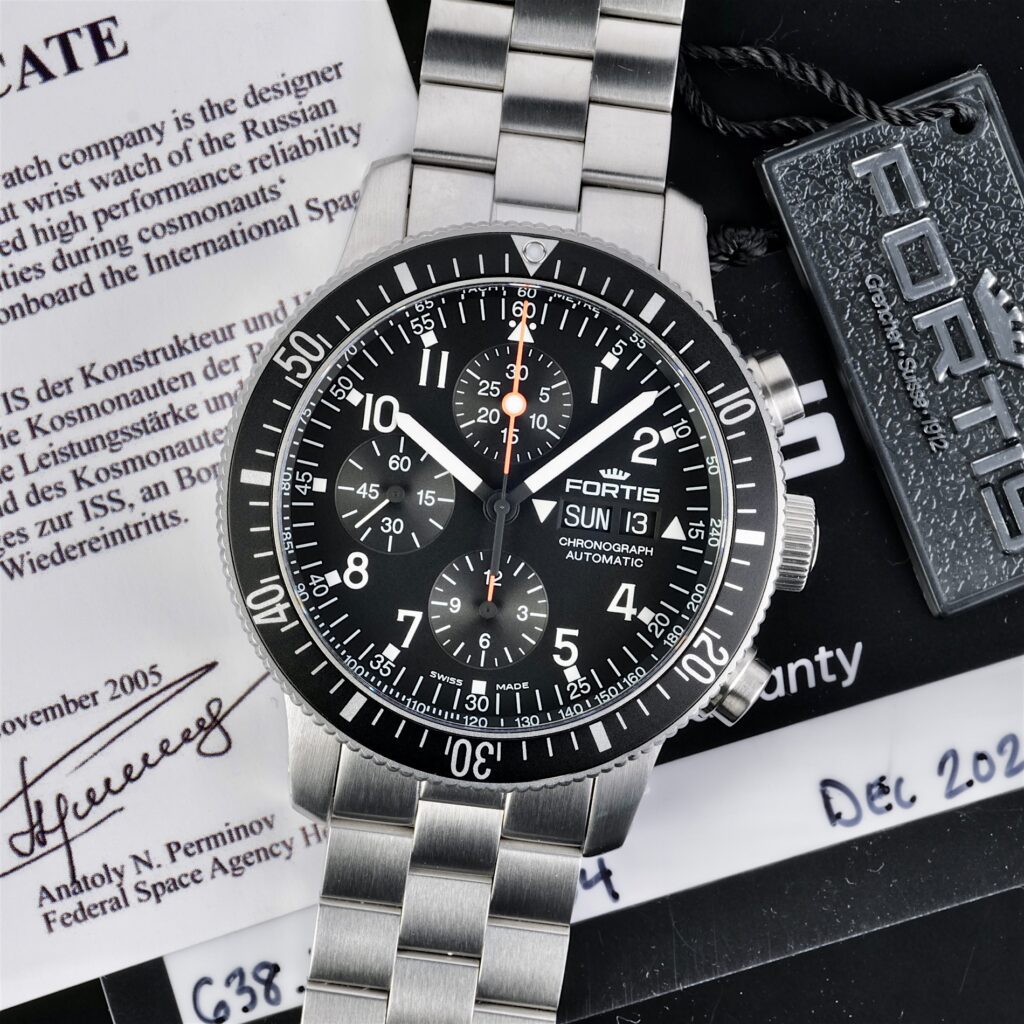
The B-42 Cosmonaut chronograph is widely recognized as the watch with the longest history in space. Interestingly, Fortis never officially discontinued the B-42 chronograph, leaving it on their website for quite some time, but it wasn’t available for around two to three years.
When Fortis’s new owner and CEO took over the company, they had plans for it due to its heritage as a reliable tool. This year, they released the N-42 Novonaut, the next evolution of the B-42 Cosmonaut chronograph. While it retains some similarities to its predecessor, it does have a different case with reduced thickness. It also features a new screw-down crown and an improved 200-meter water-resistant design. The Novonaut also comes with a quick-adjust clasp, which is a significant upgrade from the stamped clasp of the B-42. All in all, it’s a substantial improvement.
On the Wrist
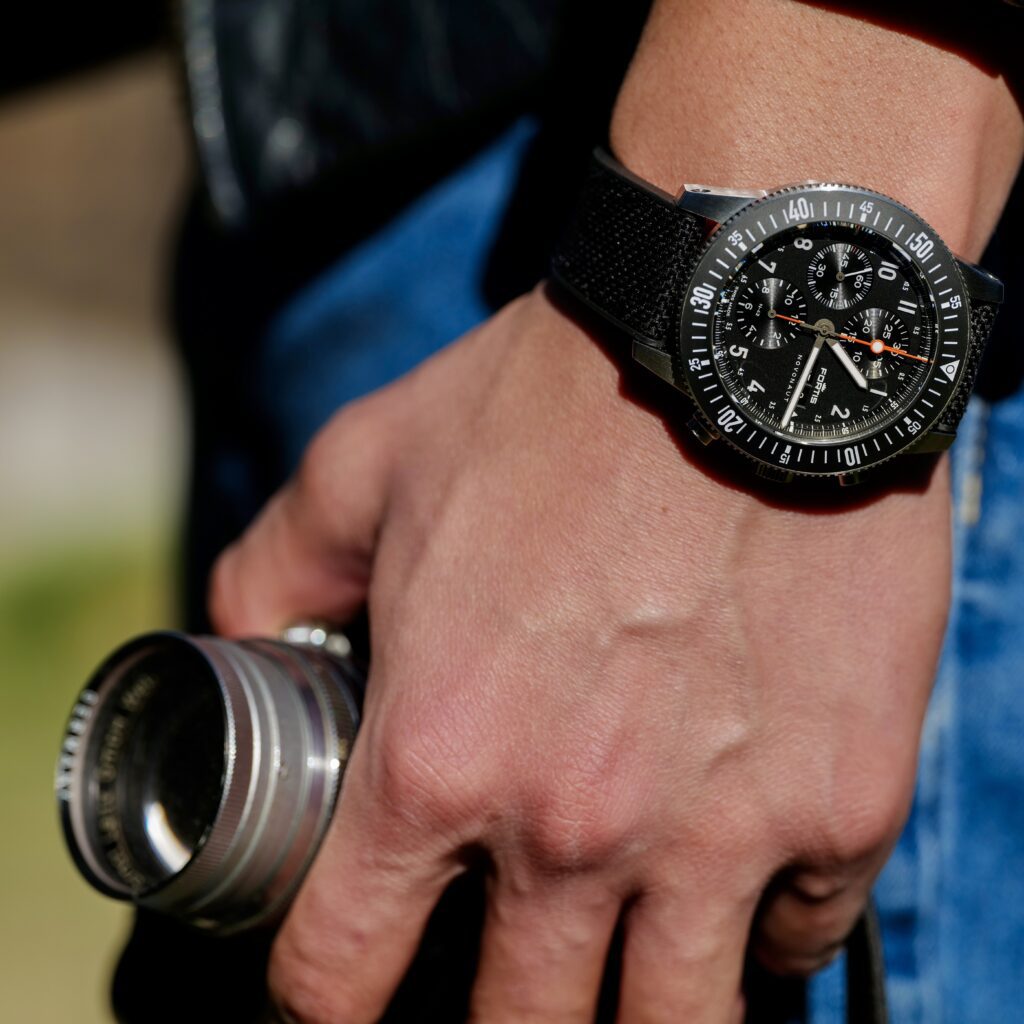
Ben: Tell us how the watch feels on the wrist.
Joseph: Despite only having a six-and-a-half-inch wrist, I don’t find the newer collection of Fortis watches, known for their larger tool watches, overly large. I wore a B-42 Cosmonaut Chronograph for about six months, and while I liked it, it often felt too big for my wrist.
However, I don’t have that issue with the Novonaut. Even though it’s a decent size, the new Novonaut case design is more comfortable on smaller wrists. The lugs angle downwards towards the wrist, making the lug-to-lug height more suitable for smaller wrists.
It’s interesting how Fortis handled the design of this watch. In the Rolex world, many collectors were not pleased when Rolex adopted a ceramic bezel, as it gave the watches a dressier look. There’s a noticeable difference between the black dial with a matte ceramic insert and the blue dial with a blue ceramic insert. Despite this, they’ve successfully maintained the tool-like appearance of the black dial watch. In fact, I’d say it looks even more so.
I’m currently wearing the new Matte Black or Legacy edition Novonaut, and the bezel design is quite distinctive. Depending on the angle and lighting, it can even appear more grayish than black.
Ben: If I’m not mistaken, the Novonaut comes in three “finish” options, Gloss Black on the First Edition, Gloss Blue on the Cobalt Blue Edition, and Matte Black on the Legacy Edition with both strap and block bracelet options.

Joseph: Both pieces are fantastic and distinct enough that you could justify owning both, much like collectors who own multiple Submariners in different colors and generations. The first watch I had was the Legacy Matte Black Novonaut, which I wore for about a month and a half. Then, I switched to the Cobalt Blue, and now I’m back to the black. I can confidently say that they feel like very different watches due to the dial and bezel.

You could designate one as your everyday watch and the other for special occasions. Currently, I’m alternating between them both. I’ve worn the blue on a strap and a bracelet and the black in both ways as well. The Fortis bracelet is a serious contender, every bit as sturdy as a tool watch bracelet should be.
I’ve also tried them on NATO straps, where there’s no material between my wrist and the case back. Because the watches are a little over 15mm high, I didn’t want to add any more height, although some people can pull it off. Personally, I felt that the blue Novonaut looked better on a strap, while I preferred the black watch on a bracelet. It’s an interesting contrast. I think the blue dial with the bracelet was perhaps a bit too flashy for me, but switching it to a strap toned it down slightly.
When using the “Nato” style straps that down pass under the case back, there is no need to worry about a spring bar breaking on these watches. The Screw and Nut bar system on these watches is extremely well-built. The strap would probably break before the bar broke.
The Mechanics

Ben: Let’s discuss the mechanics of the N-42 Novonaut a bit more. What are your impressions of the external mechanics and the Werk 17 movement inside?
Joseph: I feel like what Jupp has done with Fortis versus before is that he has worked very hard at keeping in tune with its past and the Fortis fan base while revitalizing the brand and attracting new fans by taking the products to that next level with advancing technologies, but without sacrificing the true tool-watch aesthetic that prior Fortis models had. You talk about the movement, the Novonaut’s WERK 17 movement has a 60-hour power reserve which is impressive. The old B-42 was running a Valjoux 7750, which, compared to the WERK 17, has some similarities. You’ll still get the classic wobble from the rotor spinning that 7750 watches are known for. But, with the new movement, you’ve actually got a column wheel chronograph. And pretty much any of the higher-end chronographs are going to be a column wheel. When I pick up a column wheel chronograph and start it automatically, I can feel if it is a column wheel or not by how smoothly that secondhand starts. It’s just so much smoother versus that of a 7750 movement. When I handled both watches (the B-42 vs. Novonaut), the fit and finish of the new watches were substantially superior, but at the same time, they kept that tool watch aesthetic, that tool watches ethos and effectively took the new Novonaut to the next level of quality and finishing.

In my own collection, I’ve had Submariners, Tudors, Rolexes, and even some Seikos, and people talk about bezel action. The Novanaut is a unidirectional bezel, and it’s not 120 clicks, but it feels so well-machined. It’s an instrument. That’s a great way to explain the whole ethos of this watch, a precision instrument.
As watch enthusiasts know, the Speedmaster is the one brand that passed all the strenuous tests despite being a regular production watch not specifically made for NASA or space. This pattern can be seen with other brands too, such as the Pogue watch, which has a rich history in space travel.
Initially, space travel was dominated by pilots who often chose to wear the same watches in space that they did when flying fighter jets. These were regular consumer watches that these pilots adopted for their space travel.
Fortis, for instance, when they got the contract with the Russian space agency, tested their watches just like other brands. Over time, however, the practical needs of astronauts, who often wear gloves and deal with different conditions than on Earth, became more apparent. Anyone who has ever worn gloves, even just regular cycling gloves, knows it’s harder to manipulate a watch.

Looking at a Speedmaster or a Seiko Pogue, or any other watch adopted for space, you’ll realize how difficult it is to use with gloves on. This led to collaborations like the one between the Russian space agency and Fortis to design a watch specifically for space travel, addressing issues like the need for larger pushers and crowns.
Fortis, in the 90s, was one of the first, and to my understanding, the only watch company to design a watch with a space agency. The B-42 Cosmonaut chronograph was a watch designed with the Russian space agency, not a pre-existing model. This is quite unique in the watch industry, given the niche market of designing watches specifically for space.
Using a modern Speedmaster requires the same level of care as a 1960s Speedmaster despite the enhanced water resistance of the new models. In contrast, the Novonaut is not a watch that causes excessive concern. In my everyday life, I frequently work on Hi-Fi and Home Audio installations when not engaged in watch shop responsibilities. There are no problems wearing this watch while lifting a 100-pound McIntosh amplifier into a rack, even if it gets bumped or banged around. While it’s not scratch-proof, it’s highly unlikely that you’ll damage a Novonaut.
The “built for space first” mantra from Fortis results in a watch that is way overbuilt for our purposes on Earth, and I think that’s pretty attractive in a tool watch, in my opinion.
Ben: Any plans to use the Novonaut as a Hammer while working?
Joseph: Ha! No, I probably wouldn’t go that far, but I bet you could!
Ben: The feeling on the wrist is substantial I’m sure, It is with my B-42 case Aeromaster, but that’s kind of what you’re going for in a watch like this.**** It is akin to the difference between picking up a Leica Q camera and then picking up an SL camera or maybe something along those lines where it’s like you’re going from something that’s much more delicate to a much more robust tool. You just know it is going to withstand any abuse you put it through. It’s reassuring.

Joseph: Yeah. That’s a really good analogy. Honestly, I’ve got an M, and we use an SL2 for all of our photography for CW Watch Shop. So It gets a lot of use. And I try to use the Leica SL2 when we’re doing lifestyle photography for a CW Watch Shop as well. So it goes outside and doesn’t just get left indoors. And that’s a very good analogy. It does have that comparison of an R9. It’s not an R9 DMR. But you could see where that build quality stems from and how it has progressed over time.
Ben: The Cosmonaut is like an R9 DMR… it’s kind of like the original cosmonauts, and then we’ve got the SL. That’s the Novonaut.
Joseph: Exactly!
Ben: It’s the same progression.
Joseph: Yes, I used an R9, specifically an R9 DMR, for about three years. I still adore this camera because of its unique feel. A sense of nostalgia comes with it, yet it’s incredibly robust. It feels like it would continue to function even in the direst circumstances. Imagine, a hundred years from now, someone emerging from a bunker and coming across this camera – it would probably still work.
Ben: There’s a unique satisfaction that comes from using a well-built tool. You can trust in its reliability, knowing it will withstand any kind of abuse and continue to function. That’s the joy of using well-made tools.
The Watch At A Glance
| Movement | Werk 17 Automatic column wheel chronograph |
| Case Width | 42mm (44mm at the Bezel) |
| Case Height | 15mm |
| Lug Width | 21mm |
| Power Reserve | 60hrs |
| Strap Options | Block Bracelet or Hybrid Strap |
| Water Resistance | 200m | 600ft | 20atm |
| Weight | 115g (What head only) |
| Case Material | Recycled Stainless Steel |
| Bezel Type | bidirectional sirius bezel with superluminova® X1 |
The Fortis N-42 Novonaut as well as other Fortis tool watches and more can be purchased through the Watch Shop at Camera West stores.
Benjamin Carpenter




